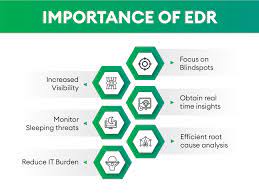Endpoint Detection and Response Tools: The Best Antivirus Solution
Updated on June 23, 2023, by OpenEDR

Ensuring the cybersecurity of all endpoints associated with a network, including laptops, mobiles, IoTs, etc., has always been a challenge for companies and organizations. With the evolution and increase in the frequency and severity of cyber-attacks, conventional antivirus solutions have failed to provide foolproof detection and protection against stealthy malware attacks. It creates the need for companies to shift to a better and more reliable antivirus solution.
Gradually, EDR or Endpoint Detection and Response tools have emerged as the most competent and effective antivirus solutions for people and organizations struggling with such issues. Given its efficiency in continuously monitoring, detecting, and removing threats from endpoints, it has been acknowledged and adopted as the best cybersecurity protection software all over the world. Getting a more detailed insight into the features and advantages of Endpoint Detection and Response tools will help you understand their prominence and proficiency as the best antivirus solution in an elaborate manner. So, let us move forward and learn more about EDR.

What Do We Mean By Endpoint Detection and Response Tools?
Endpoint Detection and Response Tools refer to the types of cybersecurity tools that are used to identify, analyze, remove, and quarantine the suspicious malware present in an endpoint system. These tools safeguard the entire network against possible malware intrusions by continuously monitoring all the endpoints connected to a network. These tools are possibly the best way to track down and handle a malware attack on a network environment. They are, undoubtedly, the most essential component of an EDR solution system.
How do Endpoint Detection and Response Tools work to safeguard the company network from potential cybersecurity threats?
Endpoint Detection and Response Tools continuously monitor the events from the laptops, desktops, mobiles, servers, IoTs, and cloud connections to identify suspicious activities and encroachments. They raise an alert to the security team to further analyze the detected malware and remediate the issue. They collected all the immediate and correlated telemetry data along with other contextual information to quicken the response time taken by the security team. It eventually helps in blocking malicious malware, ransomware, viruses, adware, spyware, and trojans from spreading further in the network before any significant damage.
The need for organizations to have reliable Endpoint Detection and Response Tools like OpenEDR integrated with their network is more than ever. There is a continuous increase in the events of opportunistic attacks as well as more advanced attacks on multiple endpoints for attempting intrusion into a company network.
In such cases, Endpoint Detection and Response Tools ensure the overall security of the network and data of an organization from any possible threats or attacks.
What are the key features possessed by Endpoint Detection and Response Tools?
Robust Endpoint Detection and Response Tools like OpenEDR have the following key specifications or features to strengthen the security of the company network:
- A wide range of visibility and ML-based attack detection technology- Endpoint Detection and Response tools generally use comprehensive machine learning and analytics tools and technologies to detect even the most serious threats in no time.
- Event scoring, AI alert grouping, and a thorough root cause analysis for an accessible investigation of the incident- Endpoint Detection and Response tools like OpenEDR provide a complete and detailed image of the incident after a high-end investigation. They can automatically discover the root cause and chronology of events and alert the cybersecurity team in real time.
- A synchronized response across every enforcement point- Endpoint Detection and Response tools provide varied response options like script execution, host restore, and search and destroy to eliminate the threats and barge the attack instantly.
- Effective endpoint threat prevention- The best Endpoint Detection and Response tools, like OpenEDR, also possess antivirus and endpoint security capabilities to tackle attacks at every stage and level.
- Cloud-based cybersecurity- Cloud-based Endpoint Detection and Response tools are capable of monitoring more endpoints and users instantly as well as simultaneously. It also helps take a significant burden off the in-house servers.
- Reducing the surface and impact of the malware attack- Endpoint Detection and Response tools like OpenEDR have features like a host firewall for disk encryption and device control. These features not only block ransomware attacks but also inhibit data loss and unauthorized access.
- Optional Managed Detection and Response (MDR) services– High-quality Endpoint Detection and Response tools also have a built-in Managed Detection and Response (MDR) system for a throughout monitoring and threat hunting.
Final Thoughts about using Endpoint Detection and Response Tools.
Using Endpoint Detection and Response Tools has become an unavoidable step in assuring the cybersecurity of an organization. It not only seals and secures the endpoints but also continuously scans and monitors them for any possible threats and malware.
OpenDR is one of the best and most updated Endpoint Detection and Response tools available in the market. It has some of the most elaborate and exceptional features that promise much-enhanced surveillance of the company network for complete inhibition of cybersecurity threats and malware attacks. It uses advanced and optimal technology to become the market’s most efficient Endpoint Detection and Response tool.